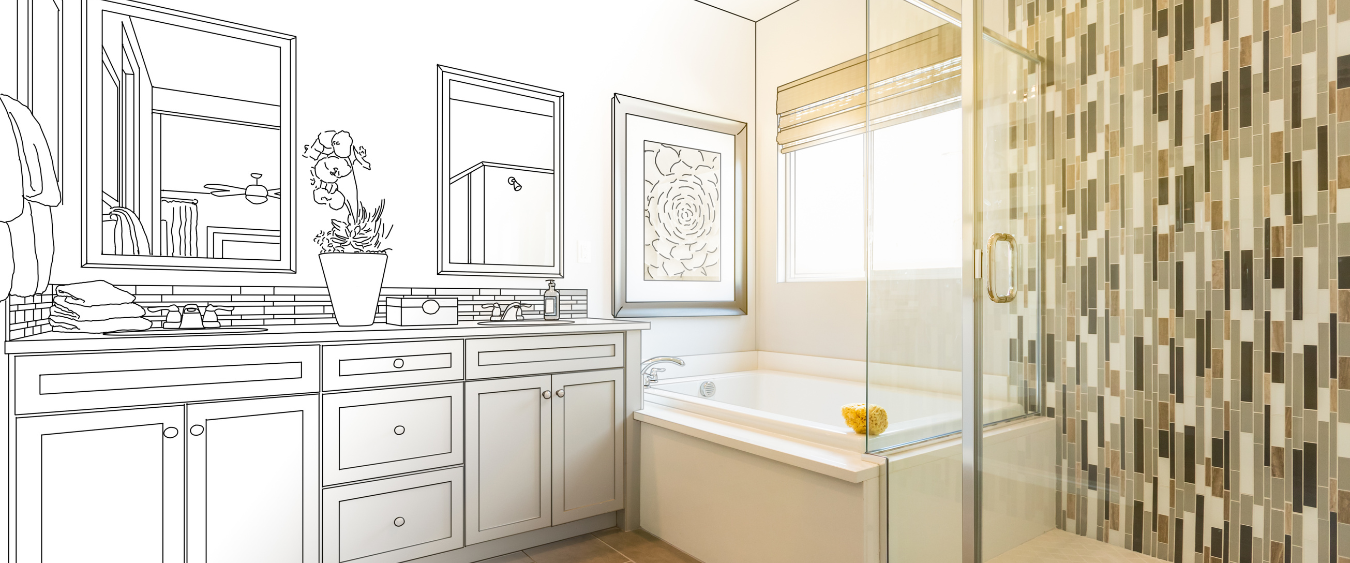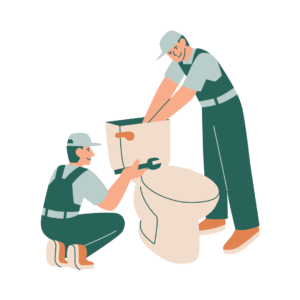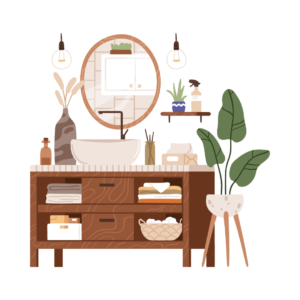Renovating Your Bathroom in India:
The Definitive Guide
January, 2024
Planning to give your bathroom a makeover and not sure of where to start and what to expect? Look no further – you’ve landed in the perfect spot.
Bathrooms are surely one of the spaces where you start and finish your day. So it is evident that it should be one of the most relaxing yet functional spaces of your home. Even with tight budgets and compact bathrooms, we’re here to show you how you can make the most of it and turn your bathroom into a refreshing space.
Whether you are planning to renovate your bathroom partially or completely, we have created a comprehensive go-to checklist to take you through the whole process. From helping you set realistic budgets to navigating the latest products and trends in the market, we’ll guide you through every aspect of the renovation process and ensure you don’t end up with any unexpected surprises. Let’s get started!
Contents
Chapter 1: Stages of Bathroom Renovation
For the unversed, renovating a bathroom can be a tedious process that takes time, money and space. Depending on the extent of the renovation, it can take from a couple of days for a quick fix to upto 2 weeks for a full bathroom remodel. It is essential that you plan the renovation well ahead of time and move things around the bathroom area to clear up some space for the work.
Any bathroom remodel goes through the following nine stages.
- Planning the Layout – At the beginning, you generally meet with an architect, an engineer or a contractor to plan the work that is to be done. You discuss your budgets, your ideas, and your timeline with them and arrive at a bathroom design. The contractor should also provide you with resources such as masons, electricians, plumbers, and painters. If they don’t, you can also find some of these resources at sanitary ware and hardware stores.
- Demolishing and Other Civil work – Once the layout is finalised, especially for a full bathroom renovation, you will begin by demolishing your old bathroom. A mason is usually called in to carry out this work. This is a time and space-consuming task that will also result in a lot of debris around the house. So ensure that the house is cleaned regularly.
- Upgrading Pipes and Other Plumbing fixtures – This step applies to those who are looking to change the location of their sanitary fixtures and showers. A plumber comes in to install fixtures for all new bathroom fittings. Depending on your choice to go for a wall-mounted toilet and/ or concealed shower panel, you may have to make a purchase decision for these fixtures at this stage itself as they will have to be installed during plumbing.
- Adding New Electrical Panels and Wirings – Next, an electrician comes in to add or modify electrical wirings for new electrical outlets and/ or new lighting fixtures based on your design.
- Painting the Walls – This stage involves painting the ceiling and walls (if applicable) with moisture-resistant satin or semi-gloss paint. You would not need to paint the walls if you choose to lay tiles on them.
- Laying the Bathroom Tiles – Once the ceiling and walls are painted, we can move on to lay the selected tiles on the floor and walls. It is good to have finished the painting job before this step, because it prevents the newly bought tiles from getting paint on them.
- Installing Exhaust fan, Lights, and Shower Doors with Frames – The next stage is installing all the new hardware that you bought. Your new exhaust fans, lights, and shower partitions.
- Installing Sink, Sanitary ware and Other Fixtures – Following the above, you will also install the next set of sanitary ware including your commode, faucet, taps, wash basin, cabinets, shelves, and grip bars.
- Adding Bathroom Accessories – Finally, you can add accessories like mirrors, soap dispensers, toothbrush holders, and furnishings like bath mat, and towels to your bathroom.
Chapter 2: Budget Breakdown – An Approximation
One of the first discussions you will have with your architect or contractor is regarding the budget. The budget will depend on the size of your bathroom, and the extent of renovation. The average size of bathrooms in urban cities is anywhere between 30 to 40 sq. feet. This is generally considered small but what is most common. The extent of renovation will depend on whether you want to renovate your bathroom entirely or partially which will be the guiding force for you planning your layout and design.
We have created a budget breakdown for such small sized bathroom renovations to help you plan your finances. Since there are different brands in the market that cater to different segments of customers, we have created a minimum budget for basic brands and a maximum budget for more premium brands.
To Note: The following charges (in rupees) are based on the market rate in a fairly big urban city of India. The rates could be higher for major metropolitan cities and lower for towns and other smaller cities. We recommend that you take the following table as a guideline and discuss with your contractor the prices that apply to your city.
| Task | Minimum (basic brands) | Maximum (more premium brands) |
|---|---|---|
| Demolition and Civil work | 10,000 | 20,000 |
| Plumbing work | 13,000 | 18,000 |
| Tile work | 70-150 per sq. feet (for basic ceramic tiles) | 150 – 200 per sq. feet (for porcelain tiles) |
| Bath fittings | 20,000 | 40,000 |
| Shower Enclosure | 8,000 | 20,000 |
| Sanitary ware | 15,000 | 30,000 |
| Painting | 5,000 | 10,000 |
Assuming that you will be laying tiles on the walls of your bathroom, your total expenses for a full bathroom renovation could range from 1L to 2L based on the brands of products you choose. Some of the expenses can be avoided if you decide to not change the bathroom layout. Again, make note that this total would be higher if you live in cities like Mumbai, Delhi, Chennai, and Bangalore.
Chapter 3: Prioritising Safety First – A Simple Checklist
Before you begin to choose features like tiles, commodes etc., it is crucial to look into the safety aspects of the bathroom. Ask yourself the following questions before you make decisions on the bathroom elements?
- How many people will be using the bathroom regularly? The answer would have an impact on the capacity of water heaters, ease of tile maintenance etc.
- Who are the users of the bathroom? Will kids and elderly people use the bathroom frequently? In such cases, you must remember to add skid-free tiles, high-rise toilets, side grab bars, and adequate lighting among other things.


Chapter 4: A Guide to Selecting the Perfect Bathroom Tiles
Choosing the right bathroom tiles can be a daunting task with so many tile options available in the market. There are indefinite choices for tile colour, material, size, texture and brand which can become overwhelming. But not to worry. All you need to remember before you choose tiles for your bathroom are that they should be durable, easy to clean and within your budget. Let’s look at some options we have.
Tile Material
Some of the most popular and affordable tiles are ceramic and porcelain/ vitrified tiles. While the former is cheaper, the latter can be more durable over time. Other materials include natural stone, cement, mosaic, granite, wood, and marble. These materials can be very expensive if you are looking to use them for the entire bathroom. They can alo be difficult to maintain and may require frequent cleaning and periodic sealing. But if you really want to bring a luxurious look to your bathroom on a budget, then you could think about using ceramic or porcelain tiles largely and use the premium ones as an accent feature. But ensure that the floor tiles are made of non-slippery materials.
Tile Colour
While this decision is fully based on your ideas, here are some tips to help you make your vision come true.
- How much natural light is present in your bathroom? Natural light generally enters the room from your bathroom windows and ventilation. Having natural light is a useful feature as it is first and foremost a free source of light, and it also helps to keep the space hygienic. So if you do not have access to natural light already, you might want to incorporate it in your renovation. Go for light coloured, earthy tones on your walls and floor if there is insufficient natural lighting. This will help make the space feel warm. But if there is adequate natural light coming into your bathroom, then you could play around with darker coloured tiles.
- How small is your space? For smaller bathrooms, it is generally advised to go for light coloured tiles to make the space appear larger.
- Do you match the wall and floor tiles? You could have the same tiles for the wall and floor with a simple change in texture. The floor tiles could have a rougher texture as it is prone to get slippery with use. You could also use complementary coloured tiles for the walls and floor. But it is best to stick to a maximum of two or three colours, especially if your bathroom is small.
Tile Size
Go for bigger sized tiles if your bathroom is small, to make it feel more spacious. But ensure that it is not too big relative to your room as it could lead to cutting and wastage. Using smaller sized tiles, especially on the floor, can also be an advantage as it can aid in being slip-resistant.
Chapter 5: What to Know Before you Choose your Toilet
Toilet Type
Toilets/ commodes are generally of two types in India – the Indian squatting toilet and the western toilet. While the former has been used for centuries in India, the latter is what is becoming more common these days due to higher comfort and convenience.
Among the western toilets, we have three types – the one-piece toilet where the whole unit is made of one piece, two piece toilet where the flushing tank and the sitting pan are separate and lastly, the wall-mounted toilet where the toilet tank is concealed behind the wall. Each of these has its own pros and cons but the third option is the most sleek, modern and expensive of them all.
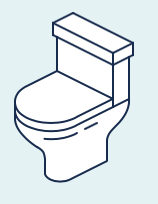
One piece toilet

Two-piece toilet

Wall-Mounted Toilet
Image Source: Tradebase – toilets and basins
Toilet Height
Toilets generally come in two heights – standard height toilets and comfort height toilets. Standard height toilets are the most common with a height of 14-15 inches from the floor. Comfort height toilets have higher seats which may be more suitable for elders, people with mobility issues and tall people.
Chapter 6: Choosing the Right Water Heater for your Needs
Water heaters have become an integral part of our bathrooms today. They help us combat the monsoons, our body aches, and manage hygiene. But there are features you need to understand before making your purchase decision. They are:
- Capacity – The capacity of your geyser will depend on the size of the family or the number of people who will use the bathroom for showers regularly. Generally, the more the number of people, the higher the capacity. At Cascade, we have calculated a simple chart to help you make the right decision for you and your family.
| Capacity | Number of Persons |
|---|---|
| 3 L | 1-2 persons |
| 6 L | 1-2 persons (high consumption with shower) |
| 10 L | 2-3 persons |
| 15 L | 2-3 persons (high consumption with shower) |
| 20 L | 3-4 persons |
| 25 L | 3-4 persons (high consumption with shower) |
To Note: This is based on the assumption that on an average, one person consumes 15 L of hot water per shower.
- Safety – One of the most crucial aspects of choosing a water heater is the safety aspect of it. At Cascade, we ensure that all our water heaters comes with advanced and cutting edge safety features including,
- Thermal cut-out to prevent appliance from overheating,
- Multi-function safety that includes a pressure-release valve and a non-return valve,
- Advanced welding technology to improve strength of Inner tank,
- Fuse-nut to protect against unforeseen electrical shocks, and
- Flame retardant 1.1m long cable.
- Mounting – Cascade water heaters have vertical, dual and multi-mounting options. For example, Cascade Tuffy max surge comes with multi-mounting options that can be installed vertically, horizontal right, horizontal left, floor and on the ceiling. This feature which only Cascade provides helps customers mount our heaters almost anywhere in their bathrooms.
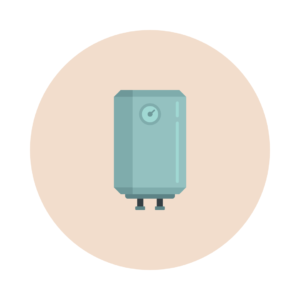
Vertical Mounting
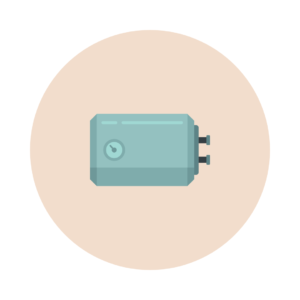
Horizontal mounting
- Wattage – This feature depends on how fast the water gets heated. Generally, instant water heaters have higher wattage as it heats water very quickly. Cascade’s electric storage water heaters come with a wattage of 2kW while the instant water heaters come with 3kW. Both types are highly energy efficient and will not increase your energy bills.
- Service – While getting a water heater installed is one thing, they are generally prone to service issues over time, especially when there is any change in the quality of water. So it is also important to choose from a brand that can provide the fastest after-sales service so that you can continue to enjoy hot showers without a break. Cascade is proud to provide the fastest after-sales service in the market. We have a network of service centres spread across Tamil Nadu, Maharashtra, Kolkata, Andhra Pradesh, Karnataka, and Kerala, geared to respond to your needs promptly.
Chapter 7: Designing a Functional Shower Area
When designing your shower area, prioritise choosing a shower head that is compatible with your bathroom’s water pressure. You have your ceiling/ rain showers, overhead showers and hand-held showers for flexibility. Secondly, keep in mind to check if water in the shower area is getting drained easily. One of the ways to improve this is to ensure that the floor is sloped slightly towards the drain. You can also use shower separators such as a partial or full glass partition with frames to create a separate space within your bathroom or you can go for an open shower concept. Another cost-effective way to separate the shower area from the rest of the bathroom is to simply use a water-resistant curtain.
Chapter 8: The Importance of Lighting and Ventilation in your Bathroom Design
Any bathroom requires adequate lighting and ventilation. We already covered the significance of natural lighting in a bathroom. Similarly, ventilation is also essential to remove excess moisture and foul odour among many other benefits. Ventilation can come in different forms – a window (also brings in natural light), an exhaust fan, or a combination of both.
Chapter 9: Tips for Choosing the Right Sanitary Fixtures and Accessories
In recent years, the sanitary ware industry has come up with some great new styles for wash basins to choose from. You have the full pedestal wash basins, half pedestal wash basins, wall mounted wash basins, table/ counter top wash basins and under-counter wash basins. Each of these come in different sizes, colours, materials and shapes. If your bathroom is not too small, you could try out the table top or under-counter styles for a luxurious effect. However, if your bathrooms are smaller in size, like in most high-rise apartments today, you could try out the pedestal or wall-mounted washbasin that are compact. With wall-mounted washbasins, you also have the opportunity to add a storage cabinet under the sink.
Other sanitary fixtures include faucets, grab bars and hangers that helps make the bathroom become more functional. There may be limited designs available in these fixtures but you could try out different coloured plating (like gold finish, brass finish, matte black etc.) on these elements.



When it comes to accessories, one of the most useful items you could have in your bathroom is the mirror. They not only help you check your face and teeth, but also reflect light into the space making it seem more spacious. If it is possible, add your mirrors (and washbasins) next to the bathroom window to boost this effect. You can opt to go for larger sized mirrors to add a sense of drama to the room. You could also install sleek mirror cabinets to add extra storage space. You could also try different shapes and frames for your mirror. However, avoid using a frame for the mirror if the size of your bathroom is small.
Conclusion
You’ve made it! We’ve come to the end of our detailed guide that took you through the entire bathroom renovation process. We trust that you’ve not only gained valuable insights but also acquired a clear understanding of what to expect throughout this transformative journey. Thank you for reading our carefully curated post and may your newly renovated bathroom bring you joy and satisfaction every day.
If you’re looking to buy a water heater for your bathroom, explore our range of cutting-edge storage and instant water heaters that are designed to meet the diverse needs of modern bathrooms, ensuring advanced safety and timely service. You can also call us on our toll-free number 1800 425 0115 and we can help you discover the perfect solution for your bathroom heating needs.
You can also follow us on


